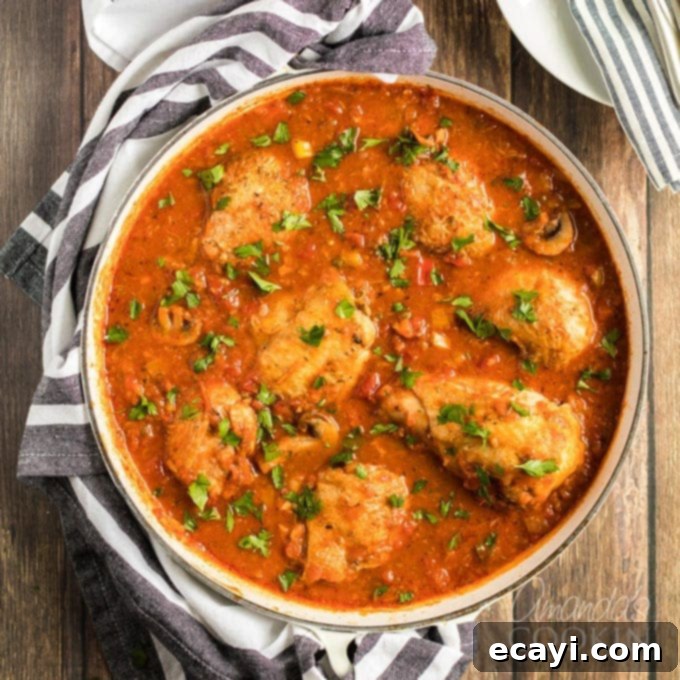Hearty & Authentic Stovetop Chicken Cacciatore: Your Ultimate Italian Comfort Food Guide
There are some dishes that just speak to the soul, and Chicken Cacciatore is undoubtedly one of them. This rustic Italian classic isn’t just a meal; it’s an experience. Imagine tender, fall-off-the-bone chicken, slow-simmered in a rich, savory tomato sauce, infused with the vibrant flavors of onions, bell peppers, garlic, and the briny pop of capers. This isn’t a dish you rush; it’s one you savor, allowing the ingredients to meld into a symphony of taste that evokes warmth and comfort with every bite.
The beauty of Chicken Cacciatore lies in its simplicity and the depth of flavor achieved through a long, slow simmer. It’s the kind of dish that makes your kitchen smell absolutely incredible, inviting everyone to gather around the table for a truly satisfying meal. Whether you’re a seasoned chef or a home cook looking for a rewarding weekend project, this classic recipe is a fantastic choice that consistently delivers robust, delicious results. If you’re craving more comforting chicken dishes, don’t miss our incredibly easy shortcut Crockpot Chicken and Dumplings – perfect for a quick, soul-warming alternative!
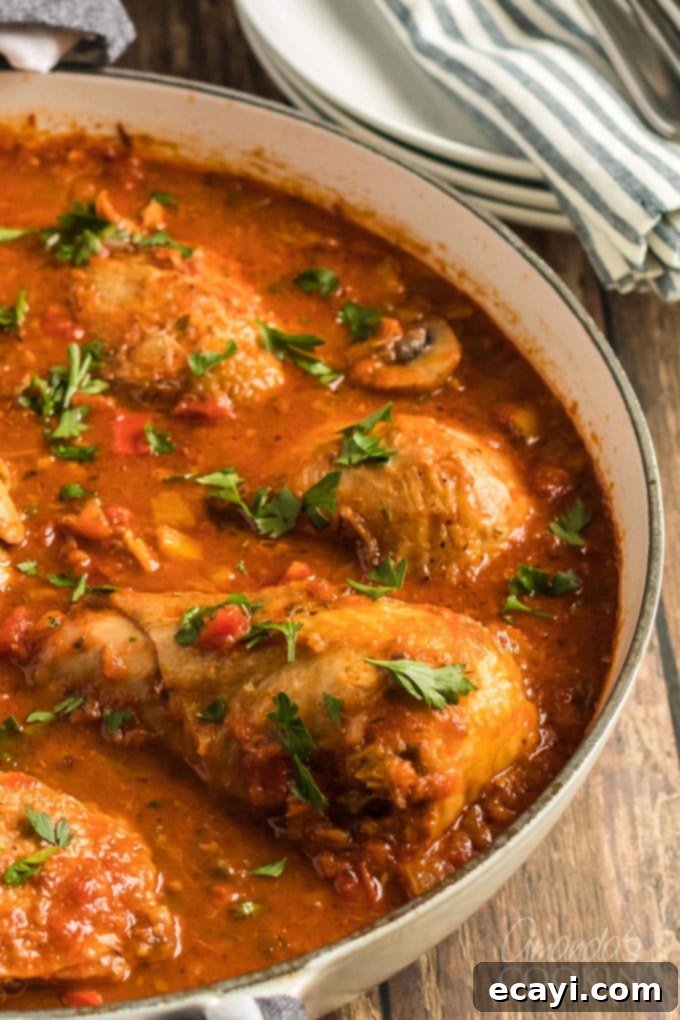
What is Chicken Cacciatore?
Chicken Cacciatore, meaning “hunter’s style chicken” in Italian, is a traditional dish that has warmed hearts and homes for generations. While there are numerous regional variations across Italy, the core concept remains the same: chicken stewed with a medley of vegetables, typically bell peppers, onions, tomatoes, and herbs. Some versions include mushrooms, while others might feature olives or different types of wine. Our recipe focuses on a rich, aromatic tomato-based sauce with the delightful addition of capers, which provide a unique salty, tangy contrast to the sweetness of the peppers and tomatoes.
This dish is a testament to the power of slow cooking. The chicken, often bone-in and skin-on, benefits immensely from the extended simmer, becoming incredibly tender and juicy, absorbing all the wonderful flavors of the sauce. The vegetables break down, thickening the sauce and adding their natural sweetness, creating a cohesive and deeply satisfying meal. It’s a perfect illustration of how simple, high-quality ingredients, when treated with patience and care, can transform into something truly extraordinary.
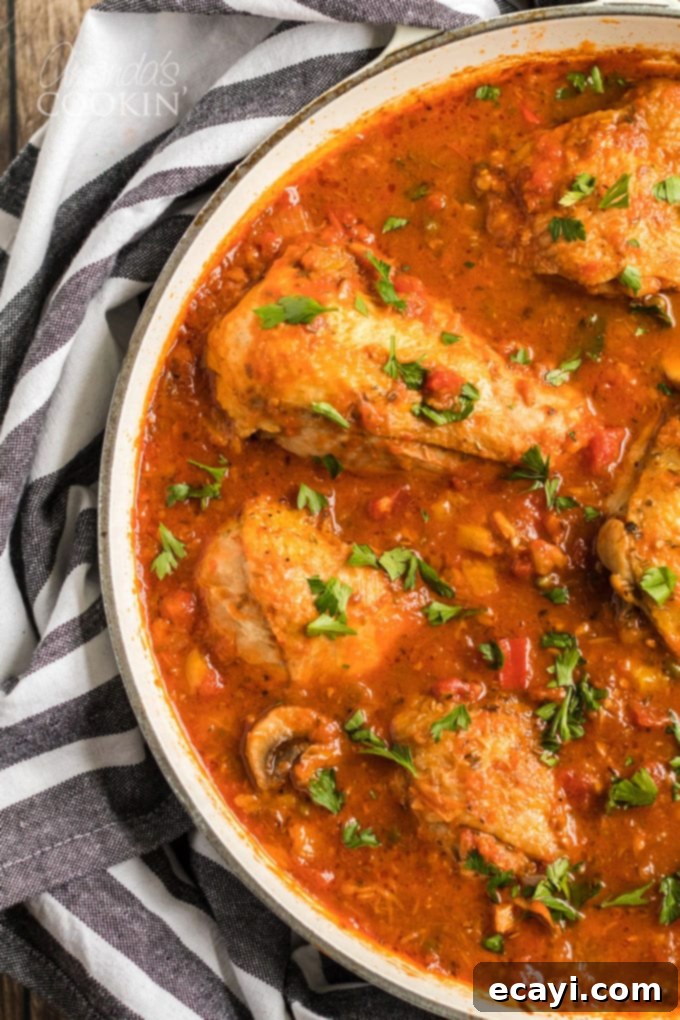
Why You’ll Love This Stovetop Chicken Cacciatore Recipe
If you’ve never experienced the magic of homemade Chicken Cacciatore, you are truly in for a treat! This recipe is a pinnacle of comfort food, offering a hearty, flavorful dish that’s both rustic and elegant. It’s incredibly versatile and can be served in a myriad of ways to suit any preference. Imagine it piled high over a bed of al dente pasta noodles, allowing the sauce to coat every strand, or served alongside creamy mashed potatoes, where the potatoes soak up all the delicious juices.
For those seeking a lower-carb option, Chicken Cacciatore pairs beautifully with fluffy cauliflower rice or fresh, vibrant zucchini noodles. Its robust flavor profile makes it suitable for various occasions, from a cozy weeknight dinner to a celebratory Sunday family meal. The aroma alone will draw everyone to the kitchen, promising a satisfying and memorable culinary experience that’s worth every minute of its slow-simmered perfection.
Mastering the Art of Stovetop Chicken Cacciatore
Embarking on this Chicken Cacciatore journey requires a bit of foresight, as this dish thrives on a slow, gentle simmer on your stovetop. This characteristic makes it absolutely perfect for a leisurely Sunday dinner with family, allowing you to enjoy the process and the incredible aromas that will fill your home. Beyond approximately 20 minutes of active prep time, you’ll need a solid two hours for the chicken cacciatore recipe to truly deepen and meld its magnificent flavors, transforming simple ingredients into a gourmet experience.
The beauty of stovetop cooking for cacciatore is the control it offers. You can easily adjust the heat and monitor the sauce, ensuring it develops into a rich, luscious consistency. This slow cooking method not only tenderizes the chicken to perfection but also allows the nuanced flavors of the herbs, vegetables, and tomatoes to fully integrate, creating a harmonious and unforgettable sauce.
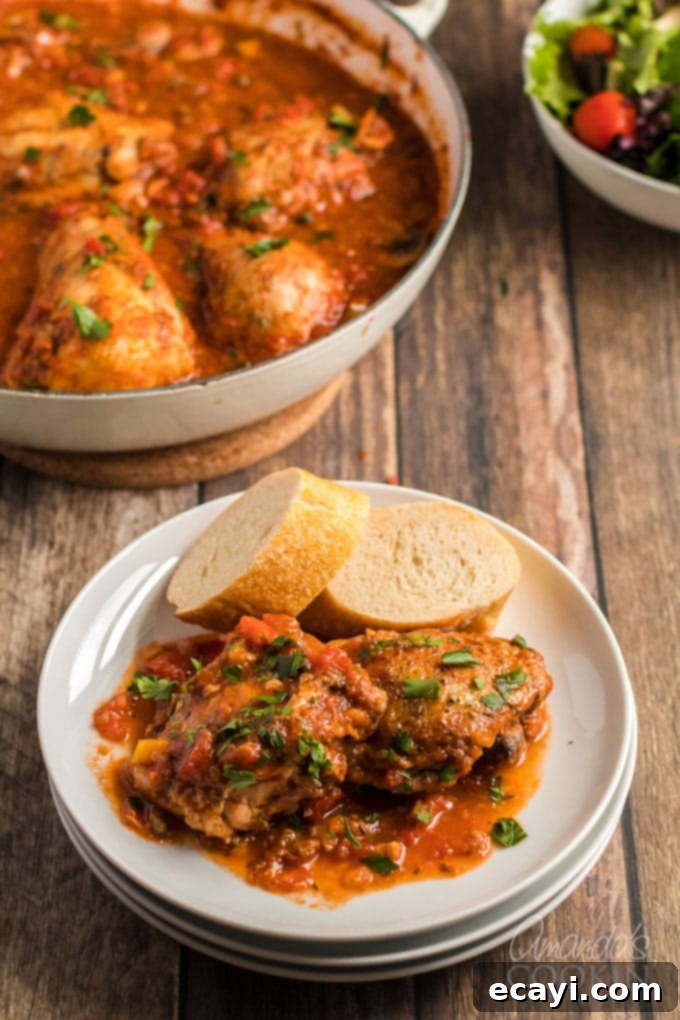
Choosing Your Chicken: For the most flavorful and tender results, we recommend using bone-in, skin-on chicken pieces. The bones add incredible depth to the sauce, while the skin helps protect the meat from drying out and crisps up beautifully during the initial browning stage. While you can use a whole fryer chicken, cut into pieces, our specific combination for this recipe included 1 chicken breast, 3 chicken thighs, and 2 chicken legs. This mix offers a wonderful variety of textures and moisture levels, ensuring every bite is exciting. Don’t shy away from dark meat; chicken thighs and legs are particularly forgiving and flavorful in slow-cooked stews like cacciatore.
Chicken Cacciatore Ingredients: The Heart of the Dish
The magic of Chicken Cacciatore comes from a harmonious blend of fresh, robust ingredients. Each component plays a vital role in building the layered flavors that make this dish so special. Using high-quality produce and flavorful chicken is key to achieving that authentic, home-cooked Italian taste.
- 4 pounds bone-in, skin-on chicken, cut up
- Salt and freshly ground black pepper
- 4 tablespoons olive oil
- 1 medium onion, chopped
- 1 medium yellow bell pepper, chopped
- 1 medium red bell pepper, chopped
- 8 ounces sliced mushrooms
- 4 cloves garlic, minced
- 2 tablespoons capers
- 3 teaspoons dried Italian seasoning OR 1.5 each of oregano and rosemary
- 1/2 cup dry red wine
- 28 ounces diced tomatoes (do not drain)
- 1 cup chicken broth or stock
- 1 bay leaf
Understanding the Ingredients:
- Chicken: As mentioned, bone-in, skin-on pieces are preferred for maximum flavor and moisture retention.
- Aromatics (Onion, Bell Peppers, Garlic): These form the foundational flavor base, sautéing them until tender sweetens the dish and creates a fragrant starting point. The colorful bell peppers not only add flavor but also vibrant visual appeal.
- Mushrooms: Sliced mushrooms add an earthy, umami depth to the sauce that complements the chicken and tomatoes beautifully.
- Capers: These small, briny flower buds are a signature ingredient in many Italian dishes, providing a wonderful piquant punch that cuts through the richness of the stew. Don’t skip them if you can help it!
- Italian Seasoning: A blend of classic Italian herbs like oregano, basil, thyme, and rosemary. If you don’t have a pre-made blend, individual dried oregano and rosemary work perfectly.
- Dry Red Wine: This is crucial for deglazing the pan and adding a complex, acidic note that enhances the overall flavor. Choose a wine you’d enjoy drinking, such as Chianti, Merlot, or Cabernet Sauvignon. If you prefer not to use alcohol, simply substitute with extra chicken broth.
- Diced Tomatoes: Canned diced tomatoes, undrained, provide the juicy, tangy base for the sauce. The liquid from the can is essential for the stewing process.
- Chicken Broth/Stock: Adds further liquid and savory depth to the sauce.
- Bay Leaf: A classic addition to stews, it imparts a subtle, aromatic depth that rounds out the flavors.
Helpful Kitchen Tools: To make your cooking experience smooth and enjoyable, here are some recommended kitchen essentials:
- Dutch oven or large skillet: Essential for browning the chicken and simmering the stew. A Dutch oven is ideal for its even heat distribution.
- Slotted spoon: For easily removing chicken and vegetables from the pan while leaving delicious drippings behind.
- Tongs: Invaluable for handling hot chicken pieces and turning vegetables.
- Liquid measuring cup: For accurate measurement of liquids like wine and broth.
- Measuring spoons: For precise seasoning and herb measurements.
Making Chicken Cacciatore: A Step-by-Step Guide to Perfection
Creating this magnificent Chicken Cacciatore is a rewarding culinary journey. Follow these detailed steps to ensure a rich, flavorful, and unforgettable meal.
- Prepare the Chicken: Begin by thoroughly rinsing your chicken pieces under cold water. This helps remove any impurities. Then, and this is a crucial step for achieving crispy skin and a good sear, pat the chicken completely dry with paper towels. Moisture on the skin prevents proper browning. Once dry, generously season the chicken all over with salt and freshly ground black pepper. Don’t be shy with the seasoning; it forms the first layer of flavor.
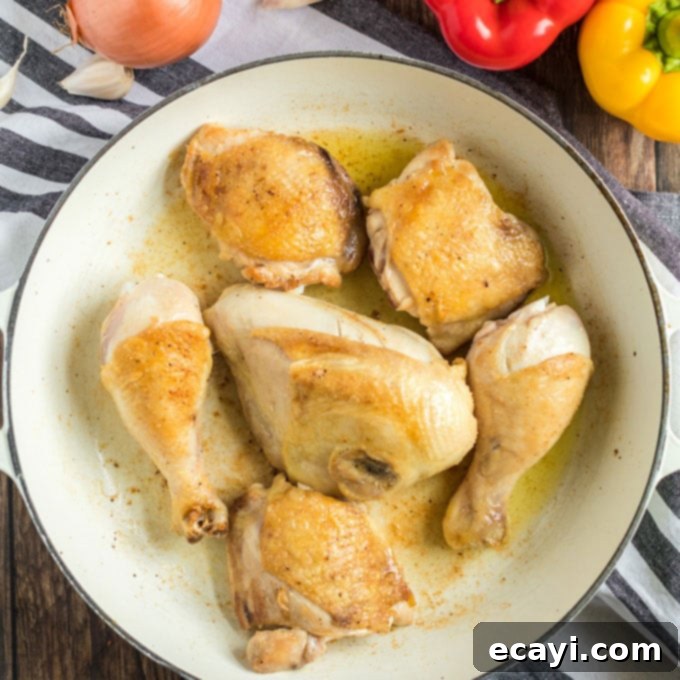
- Brown the Chicken: In your chosen Dutch oven or large skillet, warm the olive oil over medium heat until it shimmers slightly. Carefully place the seasoned chicken pieces into the hot oil, skin-side down first if applicable. Brown the chicken on all sides for about 3-4 minutes per side, until it develops a beautiful golden-brown crust. This browning process, known as the Maillard reaction, is essential for building deep, savory flavors that will permeate the entire dish. Work in batches if necessary to avoid overcrowding the pan, which can steam the chicken instead of browning it. Once browned, remove the chicken from the pan and set it aside on a plate; it doesn’t need to be cooked through at this stage.
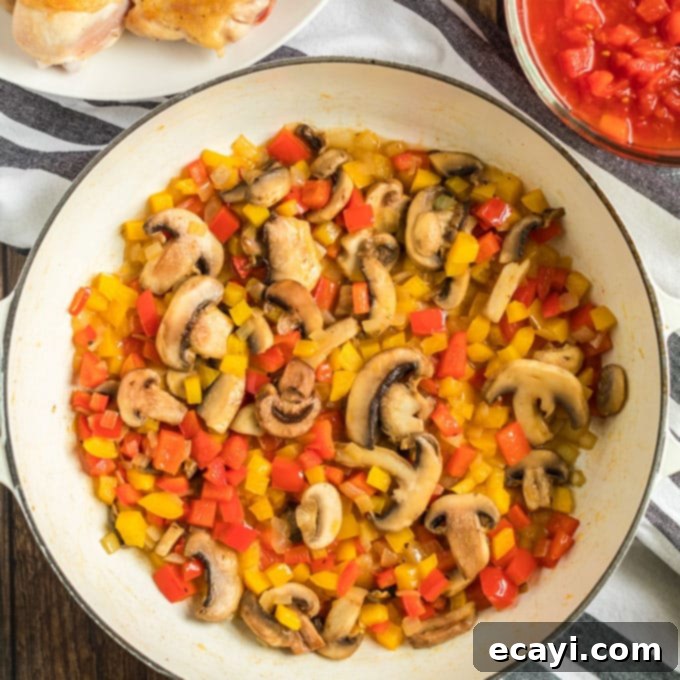
- Sauté the Vegetables: Using the same pan (and the delicious drippings left behind from the chicken), add the chopped onion and bell peppers. Sauté them over medium heat, stirring occasionally, until they become tender and slightly softened, which should take about 4-5 minutes. This step helps release their natural sweetness. Next, add the sliced mushrooms to the pan and continue to sauté for another 2-3 minutes, allowing them to release their moisture and develop a deeper flavor.
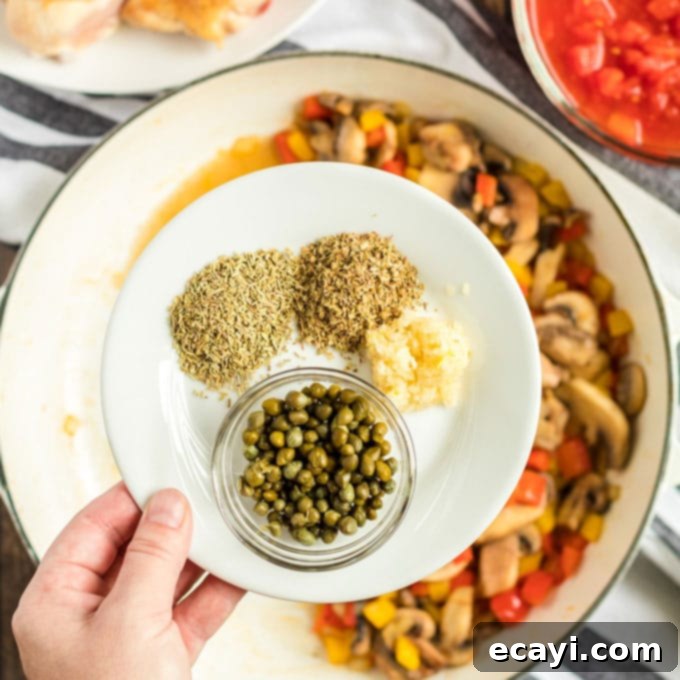
- Add Aromatics and Capers: Push the sautéed vegetables to one side of the pan to create a clear space. Add the minced garlic, capers, and dried Italian herbs directly into this cleared area. Cook, stirring constantly, for just about 1 minute. This brief sautéing allows the garlic to become fragrant and the dried herbs to “bloom,” releasing their full aromatic potential without burning. Then, mix them into the rest of the vegetables.
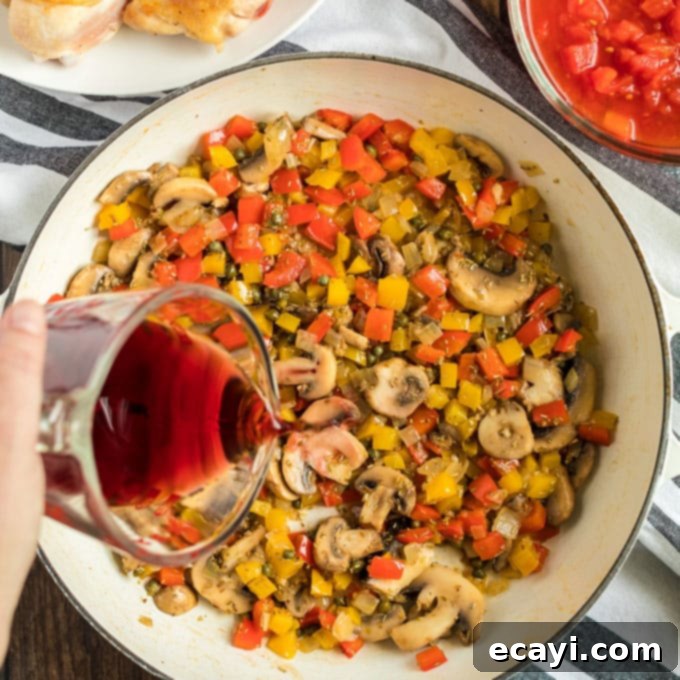
- Deglaze with Wine: Pour the dry red wine into the pan. Immediately use a wooden spoon or spatula to scrape up any browned bits (known as “fond”) stuck to the bottom of the pan. These bits are packed with intense flavor and will dissolve into the wine, enriching your sauce. Allow the wine to simmer and reduce for 3-4 minutes, letting the alcohol cook off and leaving behind its concentrated flavor.
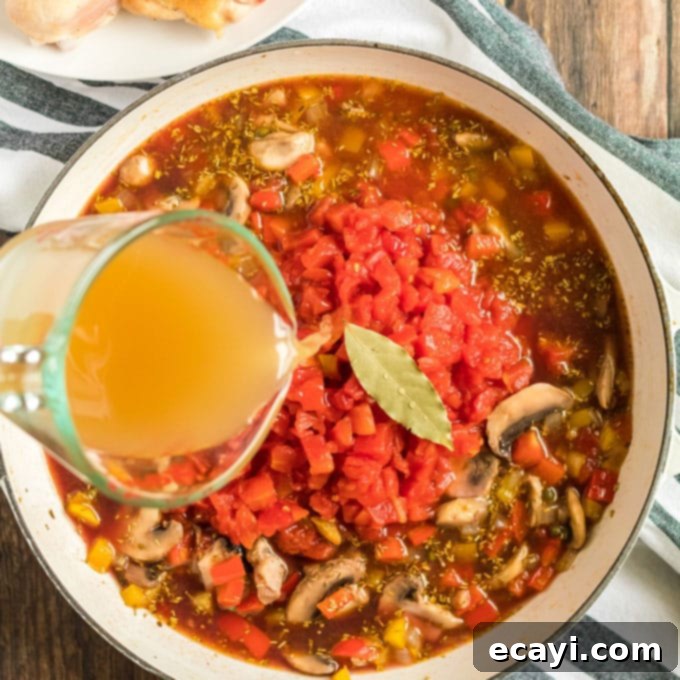
- Build the Sauce: Stir in the undrained diced tomatoes and the chicken broth or stock. Give everything a good mix to combine. Finally, add the bay leaf, which will infuse a subtle aromatic complexity during the long simmer. Bring this mixture to a low boil, then reduce the heat as directed in the next step.
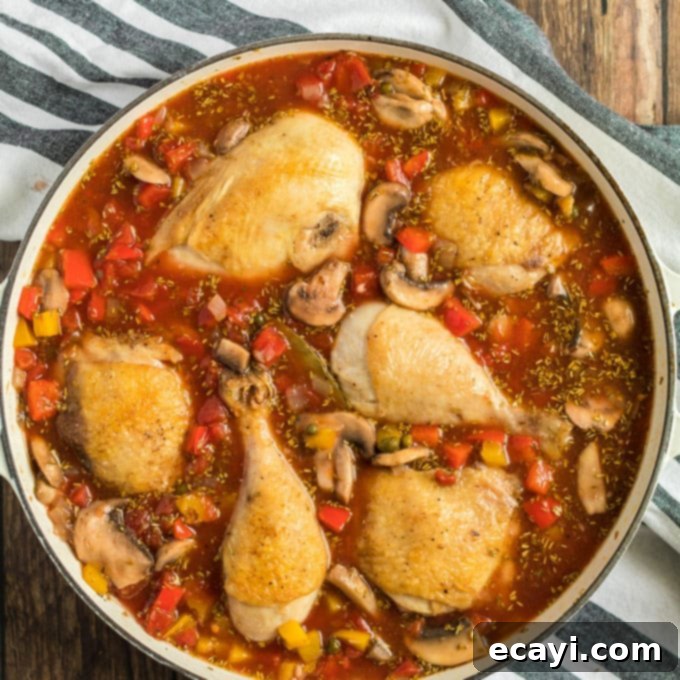
- Simmer to Perfection: Gently nestle the previously browned chicken pieces back into the tomato mixture. Ensure they are partially submerged in the delicious sauce. Bring the entire dish back to a low boil, then immediately reduce the heat to a low setting, cover the pan tightly, and let it cook undisturbed for 90 minutes. This slow simmer is where the magic happens; the chicken becomes incredibly tender, and all the flavors deepen and meld together beautifully. If you prefer your vegetables very soft, almost melting into the sauce, consider adding an additional 30 minutes to the simmering time.
Helpful Tip for a Thicker Sauce: If you find the sauce to be thinner than your preference at the end of the cooking time, simply remove the lid from the pan. Increase the heat slightly to a gentle simmer and let it cook uncovered for an additional 30 minutes. This will allow some of the excess liquid to evaporate, resulting in a wonderfully rich and thick cacciatore sauce. Stir occasionally to prevent sticking.
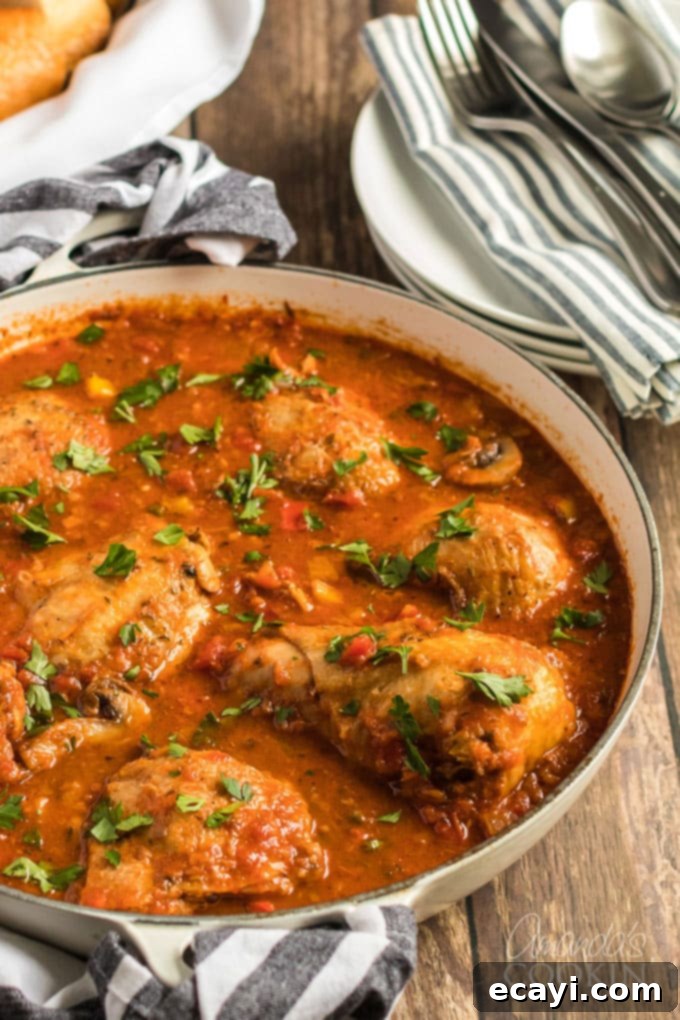
Serving Suggestions for Your Authentic Chicken Cacciatore
The versatility of Chicken Cacciatore is one of its greatest assets. Here are some delightful ways to serve it:
- Pasta: A classic pairing! Serve over spaghetti, tagliatelle, or your favorite pasta shape. The sauce clings beautifully to the noodles.
- Mashed Potatoes: Creamy mashed potatoes are an excellent absorbent bed for the rich sauce.
- Polenta: For an authentic Italian experience, a creamy polenta is a fantastic complement.
- Rice: Simple white or brown rice can also soak up the delicious flavors.
- Crusty Bread: Don’t forget a loaf of crusty Italian bread for dipping and sopping up every last drop of that incredible sauce.
- Low-Carb Options: Serve with cauliflower rice, sautéed zucchini noodles, or steamed green beans for a lighter meal.
- Garnish: A sprinkle of fresh parsley or grated Parmesan cheese just before serving adds a touch of freshness and extra flavor.
Variations and Customizations
Feel free to make this Chicken Cacciatore recipe your own! Here are a few ideas for customization:
- Add Olives: Stir in a handful of Kalamata or green olives during the last 30 minutes of simmering for an extra briny kick.
- Spice it Up: A pinch of red pepper flakes added with the garlic can introduce a subtle heat.
- Different Herbs: Fresh herbs like basil or oregano can be added at the end for a brighter flavor.
- Vegetable Swap: Feel free to add other vegetables like carrots or celery along with the onions and bell peppers for added nutrients and flavor.
- White Wine: While red wine is traditional, a dry white wine can also be used for a slightly lighter flavor profile.
Storage and Reheating
Chicken Cacciatore is one of those dishes that often tastes even better the next day as the flavors continue to meld. To store leftovers, transfer the chicken and sauce to an airtight container and refrigerate for up to 3-4 days. For longer storage, it freezes beautifully for up to 3 months. Thaw frozen cacciatore in the refrigerator overnight.
To reheat, gently warm the cacciatore on the stovetop over medium-low heat, stirring occasionally, until heated through. If it seems too thick, you can add a splash of chicken broth or water to reach your desired consistency. You can also reheat individual portions in the microwave, though the stovetop method often yields better results.
Frequently Asked Questions (FAQ) About Chicken Cacciatore
Here are some common questions you might have when preparing this classic dish:
- Can I use boneless chicken for Chicken Cacciatore?
Yes, you can. Boneless, skinless chicken thighs or breasts can be used, but the cooking time will be significantly shorter (around 25-30 minutes of simmering). Be mindful that boneless chicken may not impart as much flavor to the sauce, and there’s a higher risk of drying out if overcooked. If using breasts, consider cutting them into larger chunks. - What kind of red wine is best for Chicken Cacciatore?
A dry red wine is ideal. Options like Chianti, Merlot, Cabernet Sauvignon, or Pinot Noir work wonderfully. The general rule of thumb is to use a wine that you would enjoy drinking. Avoid “cooking wines” as they often contain added salt and preservatives that can negatively impact the flavor. If you prefer not to use alcohol, you can substitute the wine with an equal amount of chicken broth. - Can I make Chicken Cacciatore ahead of time?
Absolutely! Chicken Cacciatore is an excellent make-ahead meal. As mentioned, the flavors often deepen overnight, making it even more delicious the next day. Prepare the dish entirely, let it cool, then store it in an airtight container in the refrigerator. Reheat gently on the stovetop or in the oven. - What are capers, and can I omit them?
Capers are the edible flower buds of the caper bush, typically pickled in brine or salt-packed. They have a distinct salty, tangy, and slightly floral flavor. While they add a unique and traditional element to Cacciatore, if you don’t care for them or can’t find them, you can omit them. Some people might substitute with a few chopped green olives or a splash of red wine vinegar for a similar acidic tang, though the flavor won’t be identical. - How can I prevent my chicken from being dry?
Using bone-in, skin-on chicken pieces is the first step, as the bones and skin help retain moisture. Browning the chicken quickly and then simmering it gently in the sauce ensures it stays tender. Avoid overcooking, especially if using boneless cuts. The slow, moist environment of the stew is generally very forgiving for chicken.
Chicken Cacciatore is truly a favorite dinner of ours, and one that consistently finds its way into our meal rotation a few times every year. It’s an ideal dish for those cool spring or crisp fall evenings when you crave something hearty and warming, and it’s always a hit for family dinner. We genuinely hope you enjoy preparing and savoring this incredible Italian classic as much as we do!
More Comfort Food Recipes to Warm Your Soul
We are firm believers in the power of comfort food to make any day better! Here are several more of our tried-and-true favorites that we highly recommend you try. Be sure to explore all of our extensive dinner recipes here for more delicious ideas.
- Dutch Oven Goulash is a robust and incredibly satisfying dish packed full of rich, meaty broth, tender chunks of beef, and hearty vegetables. It’s the perfect one-pot meal for a chilly evening.
- Pasta Primavera is not only delightfully delicious but also truly beautiful to behold! Studded with a colorful array of fresh seasonal vegetables, it’s a wonderful and light addition to your Meatless Monday rotation.
- Crockpot Roast Beef is a true household favorite around here. Requiring only a few simple ingredients, it cooks effortlessly all day, filling your home with an absolutely amazing aroma that signals a delicious dinner is on its way.
- Creamy Crockpot Macaroni & Cheese is the undisputed epitome of comfort food! This incredibly creamy and cheesy dish makes a fantastic, indulgent lunch or can be served as a beloved side dish at dinner.
- Chicken Piccata is a deceptively simple recipe, yet it bursts with rich-bodied flavors derived from its fresh, vibrant ingredients like lemon, capers, and white wine. It’s a quick and elegant option for any night.

Chicken Cacciatore
IMPORTANT – There are often Frequently Asked Questions within the blog post that you may find helpful. Simply scroll back up to read them!
Print It
Pin It
Rate It
Save ItSaved!
Ingredients
- 3-4 pounds bone-in skin-on chicken, cut up (we used 1 breast, 3 thighs, 2 legs)
- Salt and freshly ground black pepper
- 4 tablespoons olive oil
- 1 medium onion chopped
- 1 medium yellow bell pepper chopped
- 1 medium red bell pepper chopped
- 8 ounces sliced mushrooms
- 4 cloves garlic minced
- 2 tablespoons capers
- 3 teaspoons dried Italian seasoning OR 1.5 tsp each of oregano and rosemary
- ½ cup dry red wine
- 28 ounces diced tomatoes do not drain
- 1 cup chicken broth or stock
- 1 bay leaf
Before You Begin
- For a thicker sauce, remove the lid at the end of the cooking time and let it simmer for an additional 30 minutes to thicken up.
- You can use a whole fryer chicken, cut into pieces. For this recipe, we used a combination of 1 chicken breast, 3 thighs, and 2 legs for variety and flavor.
- Ensure chicken pieces are patted completely dry before browning to achieve a good sear and crispy skin.
- Don’t overcrowd the pan when browning chicken; work in batches if necessary.
Instructions
-
Rinse chicken pieces and pat them thoroughly dry with paper towels. Season generously on all sides with salt and pepper.
-
In a Dutch oven or large skillet, warm the olive oil over medium heat until shimmering. Brown the chicken pieces on both sides for about 3-4 minutes each, until a golden crust forms. Remove the browned chicken from the pan and set it aside.
-
Add the chopped onion and bell peppers to the same pan and sauté until tender, approximately 4-5 minutes. Stir in the sliced mushrooms and sauté for another 2-3 minutes. Push the vegetables to one side of the pan. In the cleared space, add the minced garlic, capers, and dried herbs. Cook, stirring constantly, for 1 minute until fragrant, then mix with the vegetables.
-
Pour in the dry red wine. Scrape up any flavorful brown bits from the bottom of the pan with a wooden spoon. Cook for 3-4 minutes, allowing the wine to reduce slightly.
-
Stir in the undrained diced tomatoes and chicken broth. Add the bay leaf. Bring the mixture to a low boil.
-
Nestle the browned chicken pieces into the tomato mixture. Reduce the heat to low, cover the pan tightly, and cook for 90 minutes. If you prefer very soft vegetables that almost melt into the sauce, cook for an additional 30 minutes. Remove the bay leaf before serving.
Nutrition
The recipes on this blog are tested with a conventional gas oven and gas stovetop. It’s important to note that some ovens, especially as they age, can cook and bake inconsistently. Using an inexpensive oven thermometer can assure you that your oven is truly heating to the proper temperature. If you use a toaster oven or countertop oven, please keep in mind that they may not distribute heat the same as a conventional full sized oven and you may need to adjust your cooking/baking times. In the case of recipes made with a pressure cooker, air fryer, slow cooker, or other appliance, a link to the appliances we use is listed within each respective recipe. For baking recipes where measurements are given by weight, please note that results may not be the same if cups are used instead, and we can’t guarantee success with that method.
